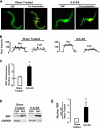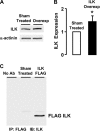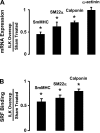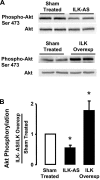Integrin-linked kinase regulates smooth muscle differentiation marker gene expression in airway tissue
- PMID: 18805960
- PMCID: PMC2604790
- DOI: 10.1152/ajplung.90202.2008
Integrin-linked kinase regulates smooth muscle differentiation marker gene expression in airway tissue
Abstract
Phenotypic changes in airway smooth muscle occur with airway inflammation and asthma. These changes may be induced by alterations in the extracellular matrix that initiate signaling pathways mediated by integrin receptors. We hypothesized that integrin-linked kinase (ILK), a multidomain protein kinase that binds to the cytoplasmic tail of beta-integrins, may be an important mediator of signaling pathways that regulate the growth and differentiation state of airway smooth muscle. We disrupted signaling pathways mediated by ILK in intact differentiated tracheal muscle tissues by depleting ILK protein using ILK antisense. The depletion of ILK protein increased the expression of the smooth muscle differentiation marker genes myosin heavy chain (SmMHC), SM22alpha, and calponin and increased the expression of SmMHC protein. Conversely, the overexpression of ILK protein reduced the mRNA levels of SmMHC, SM22alpha, and calponin and SmMHC protein. Analysis by chromatin immunoprecipitation showed that the binding of the transcriptional regulator serum response factor (SRF) to the promoters of SmMHC, SM22alpha, and calponin genes was increased in ILK-depleted tissues and decreased in tissues overexpressing ILK. ILK depletion also increased the amount of SRF that localized within the nucleus. ILK depletion and overexpression, respectively, decreased and increased the activation of its downstream substrate protein kinase B (PKB/Akt). The pharmacological inhibition of Akt activity also increased SRF binding to the promoters of smooth muscle-specific genes and increased expression of smooth muscle proteins, suggesting that ILK may exert its effects by regulating the activity of Akt. We conclude that ILK is a critical regulator of airway smooth muscle differentiation. ILK may mediate signals from integrin receptors that control airway smooth muscle differentiation in response to alterations in the extracellular matrix.
Figures









Similar articles
-
Mechanical stimuli and IL-13 interact at integrin adhesion complexes to regulate expression of smooth muscle myosin heavy chain in airway smooth muscle tissue.Am J Physiol Lung Cell Mol Physiol. 2011 Sep;301(3):L275-84. doi: 10.1152/ajplung.00043.2011. Epub 2011 Jun 3. Am J Physiol Lung Cell Mol Physiol. 2011. PMID: 21642449 Free PMC article.
-
Integrin-linked kinase regulates N-WASp-mediated actin polymerization and tension development in tracheal smooth muscle.J Biol Chem. 2007 Nov 23;282(47):34568-80. doi: 10.1074/jbc.M704966200. Epub 2007 Sep 25. J Biol Chem. 2007. PMID: 17897939
-
Role of integrin-linked kinase in the hypoxia-induced phenotypic transition of pulmonary artery smooth muscle cells: Implications for hypoxic pulmonary hypertension.Exp Cell Res. 2019 Sep 15;382(2):111476. doi: 10.1016/j.yexcr.2019.06.021. Epub 2019 Jun 28. Exp Cell Res. 2019. PMID: 31255599
-
Integrin-linked kinase (ILK): a "hot" therapeutic target.Biochem Pharmacol. 2000 Oct 15;60(8):1115-9. doi: 10.1016/s0006-2952(00)00444-5. Biochem Pharmacol. 2000. PMID: 11007949 Review.
-
Integrin linked kinase (ILK) expression and function in vascular smooth muscle cells.Cell Adh Migr. 2009 Apr-Jun;3(2):174-6. doi: 10.4161/cam.3.2.7374. Epub 2009 Apr 10. Cell Adh Migr. 2009. PMID: 19262169 Free PMC article. Review.
Cited by
-
Signaling mechanisms that regulate smooth muscle cell differentiation.Arterioscler Thromb Vasc Biol. 2011 Jul;31(7):1495-505. doi: 10.1161/ATVBAHA.110.221135. Arterioscler Thromb Vasc Biol. 2011. PMID: 21677292 Free PMC article. Review.
-
Focal adhesion kinase (FAK) and mechanical stimulation negatively regulate the transition of airway smooth muscle tissues to a synthetic phenotype.Am J Physiol Lung Cell Mol Physiol. 2016 Nov 1;311(5):L893-L902. doi: 10.1152/ajplung.00299.2016. Epub 2016 Sep 9. Am J Physiol Lung Cell Mol Physiol. 2016. PMID: 27612967 Free PMC article.
-
Quantitative in situ proximity ligation assays examining protein interactions and phosphorylation during smooth muscle contractions.Anal Biochem. 2019 Jul 15;577:1-13. doi: 10.1016/j.ab.2019.04.009. Epub 2019 Apr 11. Anal Biochem. 2019. PMID: 30981700 Free PMC article.
-
Chronic continuous positive airway pressure (CPAP) reduces airway reactivity in vivo in an allergen-induced rabbit model of asthma.J Appl Physiol (1985). 2011 Aug;111(2):353-7. doi: 10.1152/japplphysiol.01345.2010. Epub 2011 Apr 14. J Appl Physiol (1985). 2011. PMID: 21493723 Free PMC article.
-
Elastase alters contractility and promotes an inflammatory synthetic phenotype in airway smooth muscle tissues.Am J Physiol Lung Cell Mol Physiol. 2018 Apr 1;314(4):L626-L634. doi: 10.1152/ajplung.00334.2017. Epub 2017 Dec 6. Am J Physiol Lung Cell Mol Physiol. 2018. PMID: 29212803 Free PMC article.
References
Publication types
MeSH terms
Substances
Grants and funding
LinkOut - more resources
Full Text Sources
Other Literature Sources
Miscellaneous

